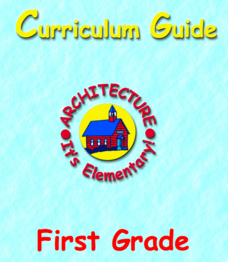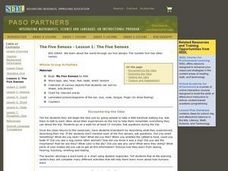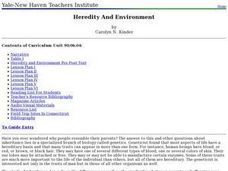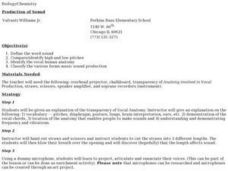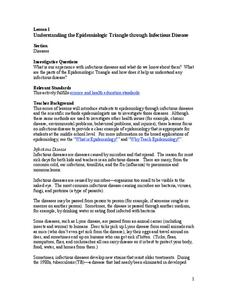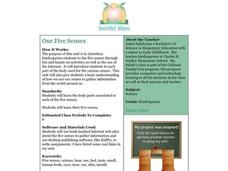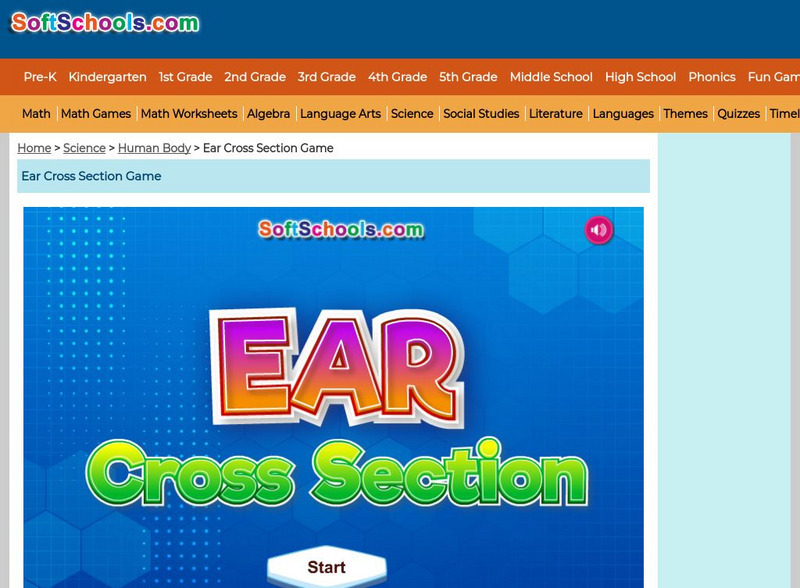American Institute of Architects
Architecture: It's Elementary!—First Grade
Build an interest and appreciation for architecture in your young learners with this fun 10-lesson art unit. Engaging children in using their five senses, the class first observes the environment around them, paying...
Centers for Disease Control and Prevention
Understanding the Epidemiologic Triangle through Infectious Disease
Introduce infectious diseases and the epidemiologic triangle. A helpful resource describes the agent, host, and environment from the three vertices as well as the time factor, which is in the middle. Scholars complete a simple...
Curated OER
The Invention of the Telephone
Learners study the history of the telephone and its inventor. In this communications lesson students complete a tuning fork experiment to further demonstrate how sound is produced.
Curated OER
A Safe Food Supply? Is Your Food Safe to Eat?
Viewers of this slide show learn that pesticides used on food crops can be harmful, but that there are certain allowable levels that should not be hazardous. They find out the rigorous process of inspection that meat must go through...
Curated OER
Elephants
In this elephants interactive activity, students read short passages of information about elephants before answering 10 multiple choice questions. They check their answers and start again if needed.
Curated OER
Evidence for Evolution
In this evidence of evolution worksheet, students review notes given by referring to the Nelson Biology text, chapter 11/13. Students read the notes and the specified pages in the text.
Curated OER
The Periodic Table of the Elements
Students research the elements used to create fireworks. In this periodic table activity, students discuss common metals, their characteristics, and their places on the periodic table. They work in small groups to research the elements...
Curated OER
The Five Senses - Barefoot Walking Trip
Young scholars go outside and take a little barefoot walking trip. They talk to each other about their experiences on the trip to help them remember everything they can. They go on a walk for at least 15 minutes. Ask questions during the...
Curated OER
Heredity And Environment
Young scholars complete a pre-test on the relationship between heredity and the environment. As a class, they write down descriptions of themselves and identify which traits can be changed and not changed. In groups, they determine...
Curated OER
Discovering Owls
Students are introduced to different types of owls and owl pellets. They list several adaptations that benefit the owls. Students identify the various species of owl that live in Wisconsin. Students discuss owl pellets and identify the...
Curated OER
Beaver Ecology
Students explore the lives of bgeahvers. They identify the physical and behavioral adaptations that help beavers survive in their environment. Students compare and contrast how beavers influence the ecology of both forest and aquatic...
Curated OER
In From Out of Town
Learners explore how the introduction of foreign species negatively affects native Hawaiian bird species. In this science lesson, students discuss how various species were introduced to Hawaii and the effects of these species on native...
Curated OER
Vocal Exploration
Students explore vocal anatomy. In this biology/music lesson, students first learn vocabulary associated with the voice and body. They then use straws, microphones and recorders to differentiate between high and low pitches and...
Curated OER
Understanding the Epidemiologic Triangle through Infectious Disease
Young scholars examine the epidemiologic triangle. In this disease lesson, students discuss infectious disease as they study how they spread and discover their families' experiences with them. Young scholars research Internet sites to...
Curated OER
The Earliest Primates
In this early primate worksheet, students will read information about the fossil evidence of the earliest primates. Students will complete 3 short answer questions based on their reading.
Curated OER
Plants of the Past
Fourth graders explore ecosystems by examining plants of the past. They discuss ways in which we interact with plants in our daily lives. Students discuss the role plants play in providing food for animals and the significance they had...
Curated OER
African Music
In this music instructional activity, students read an excerpt about African Music. Once completed, they respond to eight short answer questions related to the reading. Students also imagine that they are an African musician and suggest...
Curated OER
Our Five Senses
Pupils explore the five senses through hands-on and Internet activities.
Curated OER
Make Sense of Nature
Students participate in this program that heightens their awareness and curiosity of nature as well as their sense of adventure and exploring new surroundings. They identify and choose an object from nature after exploring it with other...
Physics Classroom
The Physics Classroom: The Human Ear
Informative article on the human ear. Describes the parts and function of the ear. Explains how the ear functions when listening to music.
Other
Deafness Research Uk: How the Ear Works
A collection of several images explains how the ear makes us hear sound.
University of New South Wales (Australia)
University of New South Wales: School of Physics: Physclips: Human Sound
Get all the information you need to know about human sound in this learning module. Module covers voice production, ear's part in hearing, resonances, and pitch.
The Franklin Institute
Franklin Institute: Music to Our Ears
Part of a larger site on the armonica, an instrument created by Ben Franklin. Introduce yourself to the human ear. This section looks at how sound is collected and transmitted and provides diagrams of the parts of the auditory pathway...
Soft Schools
Soft Schools: Ear Cross Section
An interactive labeling exercise on parts of the human ear.
